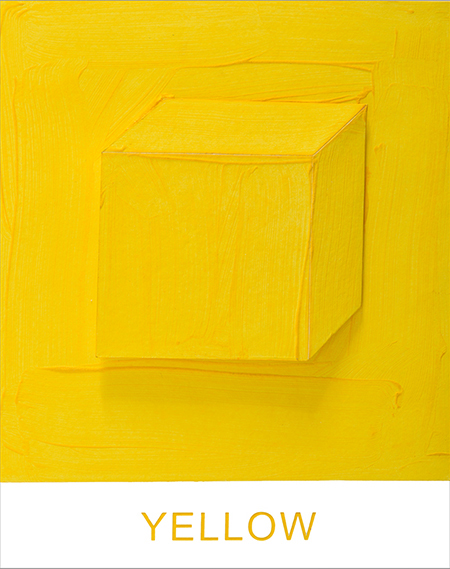
Continuing through July 15, 2017
In his collaboration with the Mixografia® printmaking studio, now spanning more than 20 years, John Baldessari has returned to ideas previously explored in other media. Mixografia® specializes in creating bas-relief prints from paper pulp. The over two dozen works on display in the exhibition space next door to the production studio reveal that the artist’s cerebral approach to art making is not to the exclusion of visual and tactile pleasure.
The most recent series of prints, “Eight Colorful Inside Jobs” (2017), is a serial transcription of one of Baldessari’s most famous time-based projects, “Six Colorful Inside Jobs” (1977). In the color film (later transferred to video), a camera is positioned over a ceilingless white room in such a way that the lighting removes all shadow and flattens out the room into a rectangle. A man dressed as a housepainter then enters and starts painting the walls and floor red. When he finishes, he leaves by the door he came in. The screen is now a red monochrome. The process is repeated with each of the primary and secondary colors, yielding in all six monochromes. The film neatly subverts the injunction drummed into every painting undergrad that painting a painting is not like painting a wall. As each coat of paint hides from view the one under it, each painting in the sequence becomes a dematerialized trace existing only on film, but with the potential to be endlessly recreated by projection onto another surface. Deflating the romantic notion of the existential painter as demiurgical creator, Baldessari’s painter is a guy doing a job, demonstrating in the process that painting is as much a performative practice as it is optical.
The “Eight Colorful Inside Jobs” prints reference this performance but turn it inside out. The Mixografia process allowed Baldessari to create eight impastoed monochromatic prints, each pregnant with a differently shaped geometric excrescence (a pyramid, a cube, a cylinder, etc.). Each print bears the name of the color it displays. Here it is volume that is conjured out of what normally would be a flat medium. The results are as aggressively optical as a conceptual work can possibly get.
Two other works worth noting are the series titled “Crowds With Shape of Reason Missing” (2012) and “A B C Art (Low Relief), Part II: PMBWFDLJ (Pangram)” (2009). The former harks back to a 1984 montage of a two overhead photographic views mounted one above the other, the one above showing a church wedding convocation and the one below a crowd in Berlin gathered to hear the declaration of war in 1914. In each instance, the cause for the gathering has been erased from the photograph, leaving a white void. The former work, possibly influenced by Baldessari’s reading of Nobel laureate Elias Canetti’s book “Crowds and Power,” came in at the time for a good deal of weighty but also abstruse critical attention.
In returning to the theme, Baldessari has used crowds assembled on cinematic sets. The voided “reasons” for the various assemblies now assume larger and more complicated organic shapes that are highlighted in relief. The process begins to yield something closer to abstraction than deconstruction, since it is the shape and texture of the contrasting areas that come to the fore. One also begins to realize that in removing the reason for the assembly of these cinematic crowds, Baldessari has insinuated a reason for crowds to assemble around his pictures, perhaps implying a parallel between the behavior of the spectacle-devouring and art-consuming publics.
“A B C Art (Low Relief),” and “Part II:PMBWFDLJ (Pangram)” are sequences of letters and pictures that mimic children’s ABC books. A pangram is a sentence that uses every letter of the alphabet at least once. The most widely known and used is “The quick brown fox jumps over the lazy dog.” Baldessari opts for "Pack my box with five dozen liquor jugs," which is two letters shorter and packs a more raffish connotation. Each letter is paired once with an illustration of an object whose designation begins with the letter. Thus, ‘P' for pins, ‘A' for ant, ‘C' for Cigar, and so on. The illustrations are in raised relief. The ‘Y' for yellow connects this series with the “Eight Colorful Jobs” series. Otherwise "ABC Art" is Baldessari playfully bridging the proximity between conceptual and pop art, something that defines his oeuvre no less than that of Ed Ruscha's.
Other items in the show, such as “Sailboat” (2008) and “Table Lamp and its Shadow A & G” (1994) function somewhat like Jasper John’s targets and flags, providing ready-made templates for building color fields and turning paper into sculpture.
